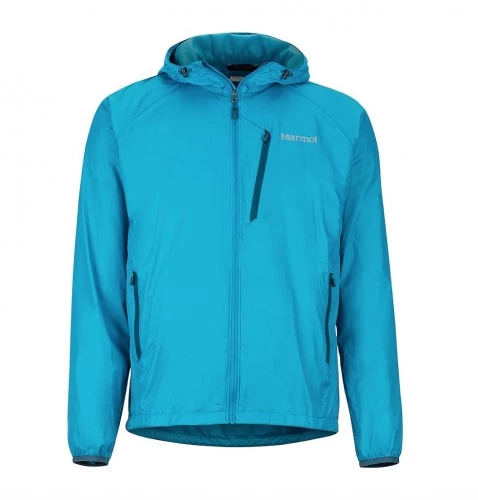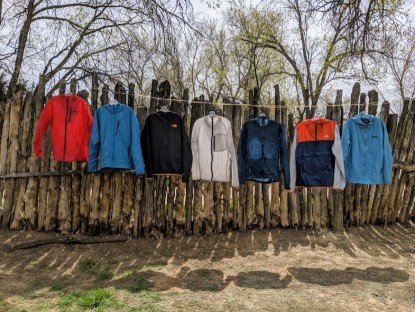Marmot Ether DriClime Review
Our Verdict
Our Analysis and Test Results
Some of the wind jackets we tested are designed to fit snug to the body and serve as a light shell over a single base layer, like a long sleeve t-shirt. Others are a bit roomier to allow for a little more layering ability, meant to be pulled out and thrown over whatever you are wearing when bad weather sets in. The Ether Hoody is a snug, athletic-fitting wind jacket that has that thin, warm layer already built-in. While the DriClime liner is a very thin piece of felt-like material, it makes a massive difference in how the jacket feels. It added significantly to the jacket's wind resistance, ranking it at the top of the pile. However, it also holds enough heat that we weren't very comfortable wearing it on warm, sunny days — even in the mountains when we wanted a little wind protection. For winter activities, such as snowshoeing or ski touring, this jacket is a comfortable and convenient layer that can be worn all day.
This jacket is excellent for wind protection, has great venting capability, and is impressively breathable even during most high-output activity. Still, we wouldn't consider this a jacket for the summer months, unless you live in the far north. With two hand pockets, a chest pocket, and numerous cinchable drawcords, this jacket has a high level of carrying-capacity and overall functionality — great for alpine climbers. While it is not the lightest or the most packable in our review, this jacket's lowest attribute is its water resistance. With its synthetic insulation, it will keep you dry in a snowstorm, but don't bet on breaking this out for protection from a quick-passing rainstorm.
Wind Resistance
The outer shell fabric of this jacket is very lightweight and quite air-permeable. Taken alone, we suspect that it would be one of the least wind-resistant materials in this review. However, it doesn't function alone --the DriClime liner, two cinchable drawcords on the hood and one on the waist, and elastic wrist cuffs all combine to provide the most wind resistance of any jacket in this test.
In our side-by-side wind testing — on a day when windchill values approached zero degrees Fahrenheit — the Ether Hoody was decidedly the most comfortable to stand out in the howling winds for any significant amount of time. Supported by a number of chilly, early-morning ski tours, this is the jacket you want to be wearing on any cold summit.
Breathability and Venting
The design of separating the liner from the outer shell material does a very good job of absorbing and evaporating perspiration — after our hose test, the synthetic insulation of this jacket dried out surprisingly quickly compared to other heavier-weight jackets. Added features, like large underarm mesh vents and zippered hand and chest pockets, aid in ventilating the jacket when on the move. If you are working up a sweat in colder weather, this jacket does a good job of drying you off to help keep you warm and comfortable.
The flip-side to this venting ability is that since the lined jacket is so much warmer than any other in this review, we found that you are certainly far more likely to work up a sweat in the first place. Once temperatures began to warm up, we couldn't wear this jacket very often — except on early morning runs or bike rides — because we simply got too hot, too quickly. If you're headed into the mountains in the spring or fall, this jacket will perform great on your early morning approach, but will likely feel stifling when hiking back down in the afternoon sun.
Weight and Packability
Our size medium weighed in at 8.1 ounces, which was curiously about one whole ounce lighter than Marmot advertised on its website. Although still very light for a (moderately) insulated jacket, this is the third heaviest in our review…
We also decided to deduct a point from this score for its packability. It stuffs into one of its hand pockets, rather than the smaller chest pocket like most of its competitors. The result is that it remains much larger once packed than most, with a size that is almost pillow-like. In fact, with half of the soft, DriClime liner exposed, we found out on a winter overnight trip that this jacket doubles as a great camping pillow! While it does include a clip-in loop, this is not a jacket we want hanging from a harness or stored anywhere but inside a pack, due to its rather thin outer layer that we worry might tear easily. While you might find that this jacket is able to be stuffed smaller than its packed-down size, weight and packability are two of the Ether Hoody's drawbacks, especially in comparison to other options in this review.
Fit and Functionality
This jacket is designed to Marmot's athletic fit, which means that it is designed to hug the body in a sleek way, not hindering movement by being too baggy or bulky. For the 5'10", 165 pound, skinny-mountaineer frame of our head tester, a medium fit perfectly — except when it came to layering. The DriClime liner is a bit grippy and sticky with other fabric, meaning you wouldn't want to try to layer underneath this jacket, or else deal with bunching fabric in the arms that might never sit just right. However, we found that thanks to its sleek fit, it was easy to throw a rain jacket on over the Ether Hoody, and that it wears very comfortably as a midlayer.
It has a healthy dose of usable features, such as insulated hand pockets, a chest pocket with a headphone port, and adjustable hood with cinchable, dual drawcords on either side of the face. While these features are great additions to a very functional jacket, they could use a little adjustment in terms of design. With the headphone port, we struggled to line up our headphone wires through the two holes in the chest pocket, only to find that it doesn't even fit a USB-C jack. Trying to cinch down the hood in a stout wind, we found it difficult to adjust the hood without unzipping the jacket partway — this could be solved by placing the pull-tabs on the outside.
Despite docking a point for user-friendliness, we found that the Ether Hoody is an incredibly functional layer for our tester's favorite winter activity - backcountry skiing. This jacket will keep you comfortable, door-to-door, for any of your cold-weather adventures.
Water Resistance
While we found that the DWR coating on this jacket was solid enough to keep us dry in snow squalls, when it came to actual water resistance, there is a lot of room for improvement. In our side-by-side hose test, the Ether Hoody scored at the bottom of the barrel — after a simulated rainstorm, we found ourselves soaked through across the shoulders and chest. This performance is significantly worse than the other heavier-weight jackets in this review.
As a result, we would not take this jacket out into the mountains as our only layer. Fortunately, the slender fit of this jacket means that it can easily be layered over with a rain jacket when the weather really turns nasty. We found the DWR coating performed well in the light, powder-snow of the Southwest, but would instead opt for a jacket like the award-winning, Editor's Choice Patagonia Houdini if you are looking for a weather-resistant shell for backcountry skiing.
Value
While the Ether Hoody is approaching the higher price range for jackets in this review, we believe its performance lives up to its price tag. It could serve as a very nice, lightweight warm layer for backpacking or alpine climbing during the warmer months — when it might be enough insulation for mornings and evenings, negating the need for a puffy. As our Top Pick for cold weather activity, this jacket is worth its weight in the mountains.
Conclusion
This is an ideal outer layer for aerobic activities during the colder side of the seasons. Its ability to block wind, while also keeping us cozy, was unrivaled in this review. We wouldn't choose to wear it in the summer months, but its wicking insulation and underarm vents will keep you cooler than expected. As the seasons turned to fall, this was our first choice for trail running and mountain biking. And as the fall turned to winter, we found ourselves wearing it on almost every ski tour. We can't recommend this jacket enough for those getting outside when the weather is cold.












